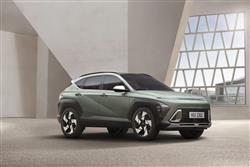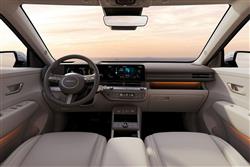Hyundai Kona - ABC Leasing
How will you view?
This is a sample, showing 30 seconds of each section.
KING KONE?(some text hidden)
By Jonathan Crouch
Ten Second Review word count: 34
Hyundai's compact Kona SUV has evolved in this second generation form. As before, there are mild and full-Hybrid options, plus an EV. And all offer more space, greater sophistication and smarter looks. Sounds promising.
Background word count: 228
Hyundai is perceived very differently now to the way it was back in 2017. And you could argue that the primary reason why is down to one model: the Kona small SUV, a car named after the Western district of the island of Hawaii. 2017 was the year combustion Konas were launched, but even more significant was the arrival of the full-battery Kona Electric a year later, which along with its close cousin the Kia e-Niro kick-started EV sales in Europe. But that original Kona model line was a little cramped inside. And felt a little cheaply furnished and low-tech for a car supposed to bridge the gap between the brand's entry-level Bayon SUV and the mid-sized Tucson model. This second generation Kona though, must do just that. Again, it shares much with its similarly engineered Kia Niro cousin, including a new K3 platform. Last time, the EV version was a spin-off; here though, the combustion variants we focus on in this Review are derived directly from the MK2 Kona Electric model that was designed first. As before with the combustion models, there's a choice of mild hybrid or full-Hybrid powertrains, but not (interestingly) a Plug-in Hybrid model; unlike its partner Kia, Hyundai sees very little future for that approach. And this second generation Kona is very much about the future - as you're about to find out.
Driving Experience word count: 269
The powertrain line-up here is divided into two parts. There are the combustion models - a 1.0-litre three cylinder mild hybrid with 120PS or a 1.6-litre four cylinder variant with 198PS. Both are offered with a choice of either iMT manual or 7DCT 7-speed auto transmission. Or you can take the electrified route. Either with the 141PS 1.6-litre full-Hybrid model we tried. Or with the full-EV Kona Electric, which is offered at entry-level with a 48.4kWh battery but will mainly be chosen in bigger-battery 65.4kWh form which offers a class-leading driving range of up to 319 miles. We'll cover the Kona Electric with its own separate Review: here, as we said, we're trying the full-Hybrid version, engineered around basically the same Smartstream 1.6-litre GDI petrol engine Hyundai's been using for a decade, mated to the same 6-speed dual clutch automatic gearbox driving the front wheels with the assistance of an electric motor. That motor's pretty much the same as previously too (developing 32kW as before), but unfortunately the tiny battery that powers it isn't, reduced in size to 1.32kWh (down from 1.56kWh before), which means it's even less likely to ever power the car on its own. Like all Konas other than the entry-level 1.0-litre model, this Hybrid gets multi-link rear suspension, but the ride is still on the firm side. That benefits the car through the turns though, where it rolls a little less than its similarly-engineered Kia Niro close cousin. With all Kona variants, you can expect a big refinement improvement thanks to the sleek aerodynamics and lessons Hyundai says it's learned from the slippery IONIQ 6.
Pictures (High res disabled)

.jpg)
.jpg)
.jpg)
.jpg)

Scoring
Category: Compact Car
| Performance | |
| Handling | |
| Comfort | |
| Space | |
| Styling | |
| Build | |
| Value | |
| Equipment | |
| Economy | 80% |
| Depreciation | 60% |
| Insurance | 60% |
| Total | 66% |